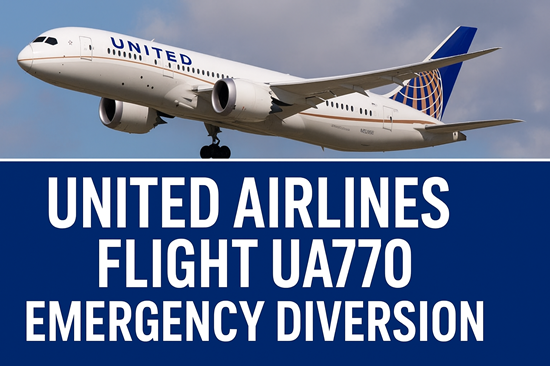Air travel is often described as one of the safest modes of transportation, but emergencies can still occur in the skies. Emergency diversion can be inconvenient, but they serve an essential role in protecting lives. Recently, United Airlines flight UA770 experienced an in-flight emergency that led to a precautionary Emergency Diversion. Though unexpected, the incident highlights how modern aviation safety protocols, experienced crew members, and efficient airport infrastructure work together to protect passengers and ensure secure outcomes.
The Flight at a Glance
United Airlines flight UA770 was scheduled to travel from Barcelona, Spain, to Chicago, USA, operated by a wide-body Boeing Dreamliner. The long-haul route crosses multiple international airspaces, requiring precise coordination and careful flight planning.
During the transatlantic journey, however, an unexpected situation forced the flight crew to declare an emergency and divert the aircraft for safety reasons.
What Triggered the Diversion?
Although exact details are typically released later by aviation authorities, Emergency Diversion of this nature are often caused by:
-
Technical Issues: Sensor alerts, engine irregularities, or cabin pressurization problems.
-
Medical Emergencies: A passenger or crew member may require urgent medical attention.
-
Precautionary Measures: Even minor anomalies may lead to precautionary landings due to aviation’s safety-first culture.
In the case of UA770, the emergency declaration was not associated with visible danger but rather a preventive safety measure taken by the cockpit crew.
The Emergency Protocol
When flight crews encounter an issue requiring immediate attention, they follow internationally recognized aviation protocols. For UA770, this included:
-
Declaring an Emergency: The pilots transmitted a “Squawk 7700” signal on their transponder—an industry-standard code that alerts air traffic controllers worldwide of a general emergency.
-
Coordinating with Air Traffic Control: Controllers immediately began providing priority routing and instructions.
-
Selecting an Alternate Airport: London Heathrow was chosen due to its excellent facilities, multiple long runways, and ability to handle large aircraft under emergency conditions.
-
Passenger Communication: The cabin crew kept travelers informed, calm, and prepared for landing.
The Diversion and Landing
After rerouting, UA770 made a safe and controlled landing at London Heathrow Airport. emergency diversion services, including fire and medical teams, were placed on standby as a precaution. The aircraft was guided to a designated gate, where technical inspections could be carried out.
Passengers were offered assistance with rebooking and accommodations as needed while the airline worked to minimize disruption to onward travel plans.
Passenger Experience
Reports from diversions like this generally describe a mix of initial anxiety and later relief. Key points passengers often note include:
-
Professionalism of the Crew: United Airlines staff are trained extensively to remain calm and provide reassurance.
-
Smooth Landing: Most passengers described the descent and landing as normal despite the “emergency” classification.
-
Clear Communication: Informative announcements helped reduce panic and maintained confidence in the crew.
United Airlines’ Response
Airlines have strict contingency plans for such events, and United’s handling of UA770 illustrates its commitment to passenger safety:
-
Immediate Technical Inspection: Engineers examined the aircraft thoroughly before any decision on continuing service.
-
Passenger Support: Meals, accommodations, and rebooking assistance were provided to those affected by delays.
-
Public Statement: Airlines typically issue updates to clarify that safety was never compromised, reaffirming trust with customers.
Why Diversions Matter
Emergency diversion can be inconvenient, but they serve an essential role in protecting lives. The UA770 incident underscores key aviation truths:
-
Safety Comes First: Airlines prioritize caution over convenience.
-
Crew Training is Vital: Pilots and flight attendants undergo continuous training for scenarios like these.
-
Airport Readiness: Major hubs such as Heathrow remain prepared to handle sudden, unscheduled arrivals.
-
Technology Saves Lives: Advanced monitoring systems can detect issues early, allowing safe preventive actions.
Final Thoughts
The emergency diversion of United Airlines Flight UA770 serves as a reminder of aviation’s unwavering commitment to safety. While it disrupted schedules, the incident was handled with professionalism, precision, and care. For passengers, it reinforced the fact that modern aviation systems are designed to prioritize human lives above all else.
Every safe landing after an emergency diversion is a testament to the coordination of flight crews, air traffic controllers, ground staff, and advanced technology working seamlessly together.







